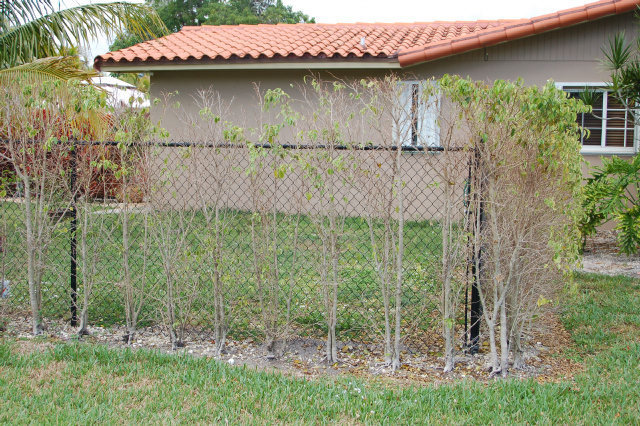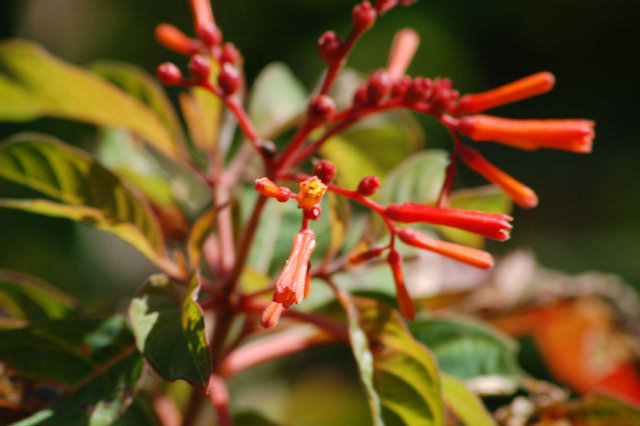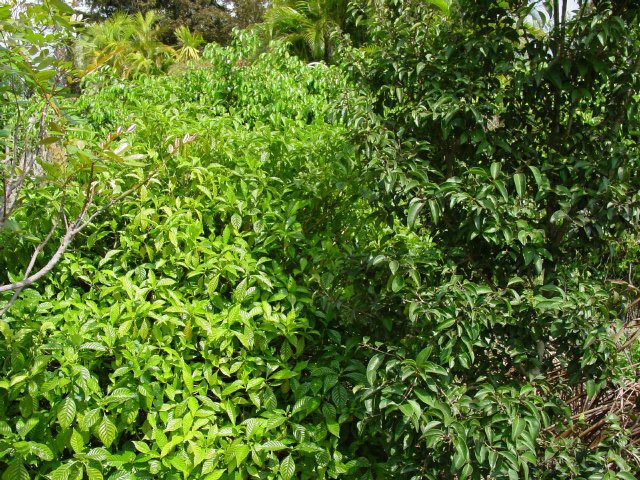The informal hedge

As published in the Miami Herald
A good hedge is a beautiful thing. In a world where we are packed together in zero lot line homes like so many sardines, hedges divide us and give us something we cherish — privacy. They can make our property a place where children can play and adults can frolic by the pool and barbeque without the prying eyes of our neighbors.
When you think of a hedge, you probably think of well-manicured hedges cut at just the proper height and perfect angle. These hedges are a monoculture and up until very recently in South Florida were most likely to be ficus hedges.
The ubiquitous ficus hedge, made up of the species Ficus benjamina, is a terrible hedge because of its propensity to be attacked and defoliated by the Ficus Whitefly. But even before the Ficus Whitefly came calling, the ficus hedge was a poor choice because it grew so fast that it needed constant trimming, and its roots sometimes caused structural damage. Ficus benjamina are, after all, trees and not shrubs and will grow to heights of 50 feet if given the correct space and nutrients.
 |
| The ficus hedge has been decimated by the Ficus Whitefly. |
Now that the king of hedges has lost its crown, we must rethink the way we create privacy around our homes.
Enter the informal hedge, consisting of multiple species of plants that are not pruned to a set level. Rather the hedge is allowed to grow at its natural height. The informal hedge will never look as tidy as its stuffy cousin, the formal hedge, but it brings a multitude of benefits.
The informal hedge is composed of several species of plants that all grow about the same height and should be staggered slightly and not planted on a direct line.
Below is information about a number of plants that work well in the informal hedge. When used together, these plants will bring butterflies, many species of birds and other wildlife to your home.
There is also no need to prune this hedge because your goal isn’t a stuffy square or rectangle; instead, it is simply a natural barrier between you and the rest of the world. Birds? Butterflies? No maintenance? Yes, yes and yes. The informal hedge is the next step in the evolution of your yard.
With the planting season just around the corner in late April, why not start planning your informal hedge today?
 |
| The firebush has hummingbird attracting blooms throughout the year. |
Use the plants below in combination based on height and watch your garden come alive with activity. None of these plants needs irrigation or fertilizer once it becomes established.
• West Indian Cherry, Prunus myrtifolia. This native tree is fast-growing and an excellent screen. The leaves are glossy and the fruit are much prized by many species of birds. Despite the name, the fruit is not edible and should be left to the birds. The tree can reach heights of 25 feet and is columnar with a spread of only 8 feet.
• Florida Boxwood, Schaefferia frutescens. This is a Florida native that is underused. Its leaves are small and dark green and the plant has small white flowers that produce fruit that will attract several species of birds. The growth rate is moderate and the plant can reach heights of ten feet with a width of eight feet. Full sun is best, but it will do well in partial shade.
• Firebush, Hamelia patens. The firebush is one of the best native plants in South Florida. Whenever anyone asks me for a great landscape plant, this one is always on my short list. Its small, red, tubular flowers give the plant its name and appear in great quantities year round. The flowers attract butterflies and hummingbirds. The 10-foot tree is highly manageable through pruning and can be kept as a 3- to 4-foot shrub. The firebush makes an excellent screen. The leaves are green with an occasional red blush and the trunk is an attractive dark brown. If the firebush is planted near the native passionflower Passiflora suberosa, you will have a complete habitat for the zebra longwing butterfly. This plant does best in full sun.
• Simpson Stopper, Myrcianthes fragrans. This is a beautiful native found in hardwood hammocks. The shrub is columnar and can reach heights of 10 feet. The leaves are small, dark green and very attractive. The small flowers are white and somewhat fragrant. The resulting small orange fruit are much sought after by birds. Full sun is best, but it will do well in partial shade.
• Red Berry Stopper, Eugenia confusa. This Florida native is handsome and will attract various species of native birds. The red berry stopper can reach heights of 15 feet with a spread of about 3 to 4 feet. New leaves and fruit are red. Mature leaves are glossy and round, coming to a pronounced point. Full sun is best, but it will do well in partial shade.
• Spanish Stopper, Eugenia foetida. The Spanish stopper has small, light green leaves and will attract native birds. This stopper will reach heights of 15 feet and will grow at a moderate rate. Full sun is best, but it will do well in partial shade.
 |
| The coffee plant mixed with any of the native stoppers creates instant privacy. |
• Wild Coffee, Psychotria nervosa. This is a native tolerant of shade, which can reach a height and spread of eight feet. The leaves are glossy and deeply grooved and very attractive. The plant is excellent as a screen or as a backdrop to bromeliads or other colorful plants. The flowers are small and white and borne in clusters which result in dark red fruit. Birds are attracted to the fruit and will spread the seeds into mulched areas of your yard.
• Jamaican Caper, Capparis cynophallophora. This is a native that will reach heights of about 10 feet and tends to be columnar. The leaves are extremely glossy and have tiny hairs on the underside that give them a velvet appearance. The flowers are an elegant white or light purple and produce fruit that attracts birds. The plant can be grown in light shade or full sun.
• Thatch Palm, Thrinax radiata. The thatch palm has dark green, palmate leaves with a yellow eye in the center of the frond. The tree produces white fruit that attracts birds. The tree grows quickly and looks best when planted in groups of three. The fast growth rate and dark green foliage make this Florida native a perfect palm to build a landscape around. The palm is sold with a single trunk or with multiple palms in the same pot. Both versions are appealing. The single palm is used as an accent while the multiple palms should be used as a screen. This palm is wider than the silver palm with a trunk of 6 to 8 inches in width. This plant does best in full sun.
Jeff Wasielewski is an outreach specialist at Fairchild, an expert in South Florida horticulture and a professor of horticulture at Miami Dade College. He can be reached at jeffw@fairchildgarden.org.
